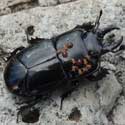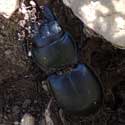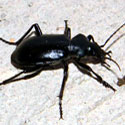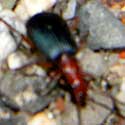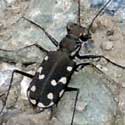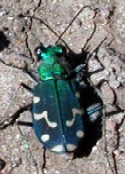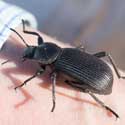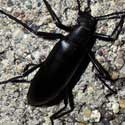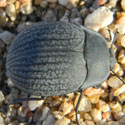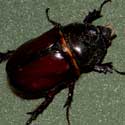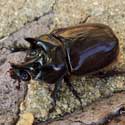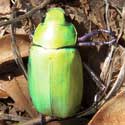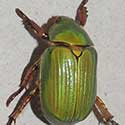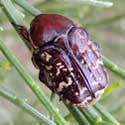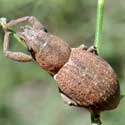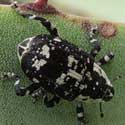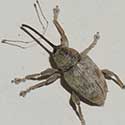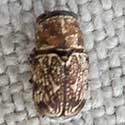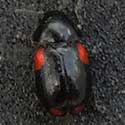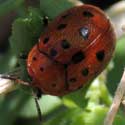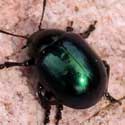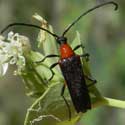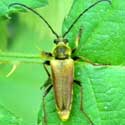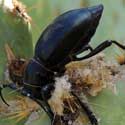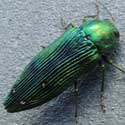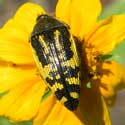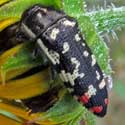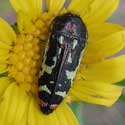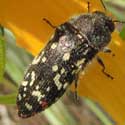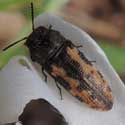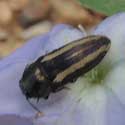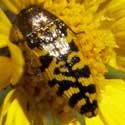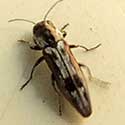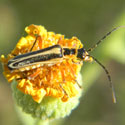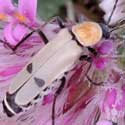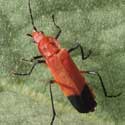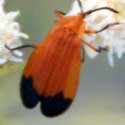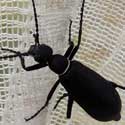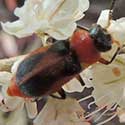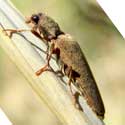Hister Beetle
Rounded rectangular shape and a pair of sharply curved mandibles face forward. This one has riders! More ...
Fierce Beetle
Runs fast, very fast. Digs well. Super sharp mandibles. Bites to draw blood. Amazing. More ...
Ground Beetle
Large, fast moving, glossy black beetle. Can pinch if mishandled or release a smelly liquid. Eats insects fallen under outdoor lighting. More ...
Bombardier Beetle
Fast moving black and fire orange. Found beneath rocks near flowing water. More ...
Tiger Beetle
Long running legs, big alert eyes, fast folding wings, and a pair of deadly mandibles. Sandy areas near water. More ...
Tiger Beetle
Active and agile predators; large eyes and long legs. Flies about and lands/runs near damp sandy soil. Bright metalic blues, greens or browns. Several species. More info
Pinacate Beetle
Large, slow moving and well armoured. Lifts tip of abdomen in air if disturbed and release bad odor. More ...
Pinacate #2
There are several similar-looking Eleodes beetles but all are slow-moving and black. More ...
Darkling Beetle
Tough little tanks that amble along ground. About 10 mm long. More ...
Ox Beetle
Large, lumbering beetles, brown to nearly black. A couple of species, some males with horns. This may be the female of the insect at right. More ...
Rhinoceros Beetle
Amazing insect! Males have three forward horns. Both females and males are very large and heavy. More ...
Grant's Hercules Beetle
Stupendous beetle - the males have a pair of stout, forward-projecting horns. Large beetles come to lights. Likely only in the highest elevations of the Sonoran Desert. More info
Beyer's Scarab
Large, pale green beetle with purple legs. Emerges at night after summer rains in Sky Islands canyons. More ...
Leconte's Chrysina
Bronze and jade jewel scarab from upper canyons in Rim Country. Emerges with monsoon rains. More ...
Chafer Beetle
Solidly built, medium large beetles. Many kinds with wide variety of color patterns. More ...
Fuller Rose Beetle
Rusty brown beetle with a distinct snout. The very hard exoskeleton has coarse, fabric-like texture. More ...
Agave Weevil
Football shaped and very hard-shelled. Found in and on century plants. More ...
Acorn Nut Weevil
The snout is drawn out into a very long slender apparatus for drilling into acorns or walnuts. More ...
Pachybrachis
When viewed from above only the front of head is visible. Small insects on flowers or new leaves. More ...
Cryptocephalus
Small but very colorful beetles on flowers or new growth leaves, esp. oaks. More ...
Morning-Glory Tortoise
Orange-red beetle spotted with black and with a turtle-like shell. Feeds on morning glory leaves. More ...
Green Potato Beetle
Convex with hard, jade-green elytra. Mostly on plants in the Solanaceae. More ...
Burro Brush Beetle
Strongly convex with stripes of tan and jade. Stays on or near burro
brush, Hymenoclea. More
...
Flower Longhorn
Many kinds of colorful cerambycids. Long antennae, first wings hardened and concealing flight wings. More ...
Golden Flower Longhorn
Elongate elyra and pronotum clothed in golden hairs. Often seen on composite flowers. More ...
Cactus Longhorn
Robust beetles with very hard exo-skeleton. Long sturdy antennae. Almost always on cactus plants. More ...
Jewel Beetle
Good-sized, metallic emerald green with distinct grooves on elytra. In higher, doug fir zone. More ...
Flower Buprestid
Glossy and brightly colored beetles sit on flowers. Many kinds with yellow, red or green markings on black. More ...
Flower Buprestid
Red and black spots on glossy black Buprestidae. More ...
Flower Buprestid
This one, sitting on a yellow composite head, has spots of red at the ends of the elytra. More ...
Red-marked Flower Buprestid
Mostly black marked with white and red. Visits composite flower heads especially in late summer. More ...
Flower Buprestid #2
Glossy beetle marked with mustard yellow and black. Sits on flowers. Many kinds with yellow, red or green markings on black. More ...
Flower Buprestid #3
Agile beetles found on blooms of various kinds. This one drabber than most. More ...
Flower Buprestid #5
Glossy black marked with yellow. Pronotum bronzy. Sits on composite flower heads especially in late summer. More ...
Hackberry Twig Borer
Metalic brown with pale markings. Small, less than 5mm. On Celtis from dead twigs. More ...
Lewis' Soldier
The elytra are soft and colorful. Frequent on flowers eating the pollen. More ...
Soldier Beetle
This large, beautiful species is found after the summer rains in canyons of southern Arizona. Commonly on flowers. More ...
Leconte's Soldier
Red and black pattern shared by several unrelated beetles and other arthropods. More ...
Net-winged Beetle
The elytra are brightly colored, leathery in texture, and with intricate pattern of raised veins. More ...
Black Blister Beetle
All satin black except for a white band on thorax. Clumsy moving and with soft wing covers. More ...
Collops Beetle
The elytra (shell wings) are soft, leathery. Orange and red marked against dark blue-gray. Common on flowers. More ...
Click Beetle
Elongated beetles with usu. tapered posterior and sharp corners to pronotum. "Clicks" to right self when positioned on back. More ...
